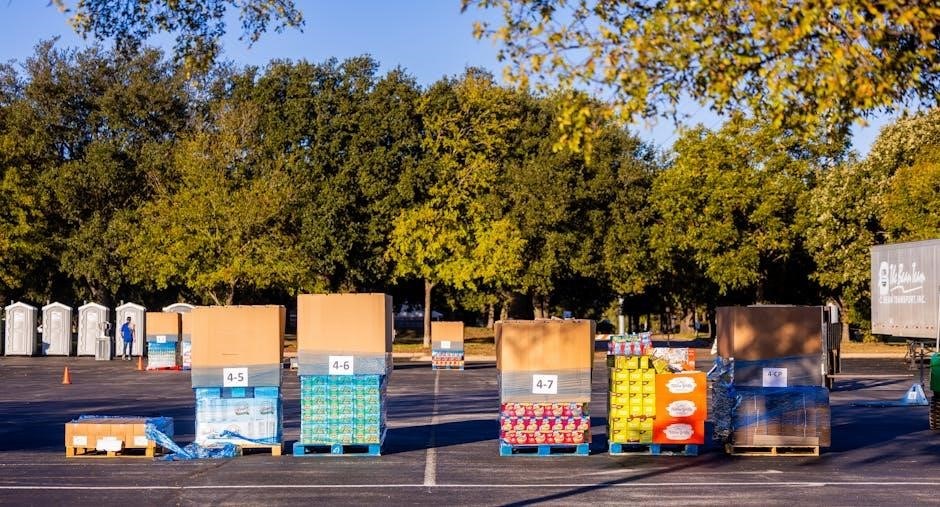This guide provides comprehensive insights into proper packaging and shipping practices, ensuring safety, compliance, and efficiency. It covers best practices, technical requirements, and essential considerations for secure shipments, addressing factors like weather, cargo characteristics, and regulatory standards. Whether you’re handling small packages or palletized freight, this resource offers expert tips and guidelines to streamline your shipping processes and adapt to industry changes, ensuring environmental responsibility and cost-effectiveness in a global market.
Overview of FCSd Packaging and Shipping
FCSd Packaging and Shipping Guide offers a comprehensive approach to ensuring safe, efficient, and compliant delivery of goods. It covers everything from small package shipments to large freight, emphasizing secure packaging methods and adherence to industry standards. The guide addresses key factors such as weather conditions, cargo characteristics, and ship motion to prevent damage. It also highlights the importance of proper labeling, materials selection, and regulatory compliance. By following FCSd guidelines, businesses can minimize risks, reduce costs, and enhance customer satisfaction. This resource is essential for anyone involved in shipping, providing clear, actionable advice to navigate the complexities of modern logistics effectively.
Importance of Proper Packaging and Shipping
Proper packaging and shipping are critical to ensuring the safe and efficient delivery of goods. They protect products from damage caused by environmental factors, handling, and transportation, reducing the risk of losses. Compliance with packaging regulations is essential to avoid legal issues and delays. Additionally, eco-friendly practices are increasingly important, as consumers and businesses prioritize sustainability. Proper packaging also enhances customer satisfaction by ensuring items arrive in perfect condition. By adhering to best practices, businesses can minimize costs, improve efficiency, and maintain a positive reputation. This guide emphasizes the significance of these practices in achieving successful and sustainable shipping operations.

Preparation for Packaging and Shipping
Understanding packaging requirements and securing cargo properly are essential for safe and efficient shipping. Consider weather, cargo characteristics, and regulatory standards to ensure compliance and minimize risks.
Understanding Packaging Requirements
Understanding packaging requirements is crucial for ensuring safe and compliant shipments. Factors like product type, shipping method, and destination influence packaging needs. Regulatory bodies enforce specific standards to protect goods during transit. Proper packaging prevents damage, reduces costs, and avoids legal issues. It’s essential to consider materials, sizing, and sealing methods to meet these requirements. For fragile or hazardous items, additional precautions are necessary. Compliance with international and domestic regulations ensures smooth delivery. Researching and adhering to these guidelines helps avoid delays and penalties. Secure packaging also enhances customer satisfaction by ensuring items arrive intact. Always verify requirements before shipping to guarantee compliance and safety.
Selecting the Right Packaging Materials
Selecting the right packaging materials is vital for ensuring product safety and cost efficiency. Consider factors like product fragility, weight, and shipping distance. Corrugated boxes, bubble wrap, and foam inserts are popular choices for fragile items. For perishables, insulated packaging with cooling elements is essential. Hazardous materials require specialized containers to meet safety regulations. Recycled and eco-friendly materials are increasingly preferred for sustainability. Proper material selection prevents damage, reduces shipping costs, and minimizes environmental impact. Always choose materials that align with your product’s specific needs and comply with shipping regulations. This ensures secure transit and customer satisfaction while promoting environmentally responsible practices.
Measuring and Weighting Your Shipment
Accurate measurement and weighing of your shipment are critical for determining shipping costs and ensuring compliance with carrier guidelines. Use a reliable scale to obtain the exact weight, and a measuring tape to record precise dimensions. Proper measurement prevents oversized shipping charges and ensures your package fits within carrier restrictions. Double-check your calculations to avoid errors. For irregularly shaped items, consider the space they occupy in the shipping container. Weight and dimensions also impact shipping method choices, such as ground, air, or freight. Precise measurements ensure efficient transit and prevent additional fees. Always verify your findings to guarantee accuracy and compliance with shipping regulations.
Best Practices for Packaging
Best practices for packaging involve using appropriate materials, efficient packing methods, and avoiding common mistakes to ensure secure, compliant, and cost-effective shipments.
General Packaging Tips
Proper packaging is essential for ensuring safe and efficient shipping. Always use sturdy, high-quality materials tailored to your item’s size and weight. Measure your shipment accurately to select the right box and avoid excess space. Cushion fragile items with padding like bubble wrap or foam inserts. Seal boxes securely with strong tape, ensuring all edges are reinforced. Label packages clearly with destination and handling instructions. Avoid overloading boxes, as this can lead to damage. Consider environmental impact by using recycled materials when possible. Stay informed about industry trends, such as the UAE’s focus on recycled plastic packaging, to adapt your practices. Efficient packing not only reduces costs but also ensures compliance with regulations and minimizes risks during transit.
Efficient Packing Methods
Efficient packing methods ensure items are protected, space is optimized, and shipping costs are minimized. Start by selecting the right box size to fit your item snugly, avoiding excessive empty space. Use high-quality materials like bubble wrap or foam inserts for fragile items. Pack heavier items at the bottom and lighter ones on top to maintain balance. Fill empty spaces with packing paper or peanuts to prevent movement. Seal boxes securely with strong tape, ensuring edges are reinforced. Consider palletizing for bulk shipments to streamline handling. Properly label each package with clear instructions. Efficient packing not only reduces damage risks but also lowers shipping costs and environmental impact, aligning with sustainability goals;
Common Mistakes to Avoid
Common mistakes in packaging and shipping include using inadequate materials, insufficient cushioning, and improper sealing. Overloading boxes or using incorrect sizes can lead to damage. Neglecting to label fragile items or failing to declare hazardous materials risks delays or penalties. Improperly measuring and weighing shipments can result in incorrect pricing. Ignoring weather conditions or cargo movement during transit can compromise safety. Using low-quality tape or insufficient padding increases the likelihood of damage; Additionally, not adhering to regulatory standards or customs requirements can cause delays or legal issues. Avoiding these mistakes ensures safer, more efficient, and compliant shipping processes, reducing costs and enhancing customer satisfaction. Proper preparation is key to avoiding these pitfalls.
Regulations and Standards
Adhering to packaging laws and standards is crucial for compliance, safety, and environmental responsibility; Stay updated on customs, safety, and environmental regulations to avoid legal issues and ensure smooth delivery.
Domestic Shipping Regulations

Domestic shipping regulations ensure compliance with national laws, safety standards, and environmental guidelines. Proper packaging, labeling, and documentation are essential to avoid delays or penalties. Materials must meet specific requirements, and items like hazardous goods require special handling. For example, shipping perishables or fragile items demands adherence to strict packaging guidelines to prevent damage. Additionally, sustainability practices, such as using recycled materials, are increasingly mandated to reduce environmental impact. Staying informed about updates, like the UAE’s focus on recycled plastic packaging, helps businesses remain compliant. Always verify local regulations and carrier-specific rules to ensure smooth domestic shipments and maintain customer satisfaction.
International Shipping Regulations
International shipping regulations require strict adherence to global standards, customs procedures, and environmental laws. Proper labeling, documentation, and compliance with import/export rules are crucial to avoid delays or penalties. Packaging must meet specific requirements for different regions, ensuring safety and sustainability. For instance, the UAE’s focus on recycled plastic packaging highlights the growing emphasis on eco-friendly practices. Additionally, updates like the 2026 battery transport regulations underscore the need to stay informed about industry changes. Accurate customs declarations and adherence to global packaging standards are essential for seamless cross-border shipments. Understanding these regulations ensures compliance, reduces risks, and facilitates efficient delivery in an increasingly complex global market.

Compliance with Packaging Laws
Compliance with packaging laws is critical to ensure legal adherence and avoid penalties. Governments worldwide enforce regulations on packaging materials, labeling, and environmental impact. For instance, the UAE’s focus on recycled plastic packaging highlights the importance of sustainability in compliance. Companies must adhere to specific standards, such as those for food safety or hazardous materials. Labelprint24 ensures compliance by meeting global packaging laws, while updates like the 2026 battery transport regulations emphasize the need to stay informed. Proper documentation and adherence to regional requirements are essential. Non-compliance can lead to fines, delays, or shipment rejection. Staying updated on changing laws ensures smooth operations and maintains trust in global markets.

Shipping Specifics
Shipping specifics involve tailored strategies for fragile, perishable, and hazardous items. Techniques include secure packaging, temperature control, and adherence to safety regulations to ensure safe and efficient delivery.
Shipping Fragile Items
Shipping fragile items requires meticulous care to prevent damage. Use high-quality materials like bubble wrap, foam inserts, and sturdy boxes to cushion items. Ensure proper sealing with strong tape and avoid overloading packages. Label fragile items clearly and consider double-boxing for extra protection. Avoid using plain white envelopes (PWE) for fragile goods, as they offer minimal protection. Always check carrier guidelines for specific requirements. Proper techniques, such as placing fragile items in the center of the box and filling empty spaces with packing paper, can significantly reduce breakage. Investing in shock-absorbing materials and adhering to best practices ensures safe delivery and minimizes claims for damages.
Shipping Perishable Goods
Shipping perishable goods demands careful planning to maintain safety and quality. Use insulated packaging with gel packs or dry ice to control temperature fluctuations. Ensure proper sealing to prevent leaks or contamination. Label packages clearly with handling instructions and expiration dates. Choose expedited shipping options to minimize transit time. Compliance with food safety regulations and packaging laws is crucial. Consider sustainable practices, such as biodegradable materials, to reduce environmental impact. Proper documentation and adherence to carrier guidelines ensure smooth delivery. Regularly monitor shipments and maintain communication with recipients to address any issues promptly. This approach ensures perishable goods arrive fresh and intact, meeting customer expectations and regulatory standards.

Shipping Hazardous Materials
Shipping hazardous materials requires strict adherence to regulations to ensure safety and compliance. Use approved packaging materials and proper labeling, including hazard class, ID numbers, and handling instructions. Documentation must include safety data sheets and shipping papers. Train personnel on handling, packaging, and emergency procedures. Stay updated on regulatory changes, such as the 2026 updates focusing on lithium battery transport. Ensure compliance with carrier and international standards to prevent incidents and delays. Properly secure shipments to withstand transit stresses. Use tracking systems for real-time monitoring. Adhere to specific guidelines for ground, air, and sea transport. Compliance ensures safe delivery and avoids legal penalties, maintaining customer trust and operational efficiency.

International Shipping Considerations
International shipping requires careful planning, including customs clearance, proper documentation, and adherence to global packaging standards. Ensure compliance with labeling requirements and regulations for smooth cross-border delivery.
Customs and Documentation
Accurate customs documentation is crucial for smooth international shipping. Ensure all paperwork, including commercial invoices and certificates of origin, is complete and compliant with destination country regulations. Proper labeling, such as Harmonized System (HS) codes, helps avoid delays. Companies like Labelprint24 specialize in ensuring compliance with global labeling standards. Stay updated on regulatory changes, such as those for lithium batteries, to prevent issues. Understanding customs procedures and required documents is essential for hassle-free delivery. Always verify specific requirements for each country to ensure adherence to local laws and avoid penalties. Organized and accurate documentation streamlines the process, reducing the risk of customs discrepancies and delays.
Labeling Requirements
Clear and accurate labeling is essential for efficient and compliant shipping. Ensure all packages include detailed product descriptions, Harmonized System (HS) codes, and handling instructions like “Fragile” or “Handle with Care.” Proper labeling helps prevent customs delays and ensures adherence to global standards. Use standardized labels and verify compliance with destination country regulations. For example, Labelprint24 ensures labels meet international requirements, reducing discrepancies. Incorrect or missing labels can lead to penalties or delivery issues. Always include shipper and recipient details prominently. Proper labeling enhances traceability and streamlines logistics, ensuring smooth delivery worldwide. Adhere to specific regulations for items like perishables or hazardous materials to maintain compliance and safety.
Global Packaging Standards
Adhering to global packaging standards ensures compliance and smooth delivery across international markets. These standards vary by region, with Europe, Asia, and North America having specific regulations. The UAE’s Ministry of Industry and Advanced Technology emphasizes recycled plastic packaging, aligning with global sustainability trends. Labelprint24 ensures packaging compliance across markets, addressing labeling and material requirements. Understanding these standards is crucial for avoiding customs issues and ensuring product safety. Eco-friendly materials and proper labeling are key to meeting global demands. By following these standards, businesses can reduce environmental impact and ensure seamless international trade, maintaining competitiveness in a global economy. Compliance with global packaging standards is non-negotiable for successful international shipping.

Sustainability in Packaging
Sustainability in packaging focuses on eco-friendly materials and practices to reduce environmental impact. Using recycled plastics and biodegradable options aligns with global trends and consumer demand for responsibility.
Eco-Friendly Packaging Materials
Eco-friendly packaging materials are essential for reducing environmental impact. Recycled plastics, biodegradable options, and sustainable resources are increasingly popular. The UAE’s Ministry of Industry and Advanced Technology promoted recycled plastic packaging in a workshop for food manufacturers, highlighting its importance. Biodegradable materials, like plant-based plastics, offer alternatives to traditional plastics, minimizing landfill waste. Additionally, using recyclable and reusable packaging reduces single-use plastics. These materials align with global sustainability trends and consumer demand for environmentally responsible practices. By adopting eco-friendly packaging, businesses can lower their carbon footprint and contribute to a greener future while meeting regulatory standards and consumer expectations for sustainable shipping solutions.
Reducing Waste in Packaging
Reducing waste in packaging is crucial for environmental sustainability. Opting for minimal packaging designs and using recyclable materials can significantly lower waste. Recycled plastics and biodegradable alternatives minimize landfill contributions. Additionally, avoiding single-use plastics and excess packaging materials helps reduce waste. Businesses can implement recycling programs and encourage customers to return packaging for reuse. Properly sealing packages to prevent empty space also reduces material usage. Educating consumers about recycling and sustainable practices further supports waste reduction. By adopting these strategies, companies can minimize their environmental impact while meeting growing consumer demand for eco-friendly solutions, aligning with global sustainability goals and regulations. This approach fosters a greener supply chain and promotes responsible consumption.
Sustainable Shipping Practices
Sustainable shipping practices are essential for minimizing environmental impact. Optimizing routes to reduce fuel consumption and emissions is a key strategy. Using electric or hybrid vehicles for deliveries can significantly lower carbon footprints. Additionally, investing in research and development for eco-friendly packaging materials and technologies supports sustainability. Governments and organizations are promoting initiatives like recycled plastic packaging to reduce waste. Educational programs, such as Penn State Extension’s course on food processing best practices, highlight the importance of sustainable methods. Encouraging customers to choose eco-friendly delivery options and providing incentives for sustainable choices further promote environmentally responsible shipping. By adopting these practices, businesses can contribute to a greener future while meeting consumer demand for sustainable solutions.
Logistics and Cost Efficiency
Efficient logistics and cost management are crucial for optimizing shipping operations. Calculating accurate shipping costs, optimizing packaging, and implementing freight strategies ensure cost savings and streamlined delivery processes.
Calculating Shipping Costs

Accurate shipping cost calculation is essential for budgeting and financial planning. Factors such as package weight, dimensions, and destination play a significant role in determining expenses. Understanding shipping carriers’ pricing structures and surcharges helps avoid unexpected costs. Additionally, fuel prices and special handling fees for items like hazardous materials or fragile goods can impact the total cost. Using online shipping calculators or tools provided by carriers can simplify the process. Proper measurement and weight documentation ensure precise calculations. Staying informed about rate changes and leveraging volume discounts can further optimize costs. Regularly reviewing shipping data helps identify trends and opportunities for savings, ensuring efficient and cost-effective logistics management.
Optimizing Packaging for Cost Savings
Optimizing packaging is crucial for reducing shipping expenses and enhancing efficiency. Using lightweight yet durable materials minimizes weight-related costs without compromising protection. Efficiently packing items to reduce empty space in boxes lowers shipping volume and saves on dimensional weight charges. Selecting the right box size for the item prevents over-packaging, which can increase costs. Additionally, consolidating shipments and utilizing flat-rate options when possible can lead to significant savings. Implementing sustainable practices, such as using recyclable materials, not only reduces waste but can also lower packaging costs. Regularly reviewing and adjusting packaging strategies ensures alignment with changing shipping rates and customer needs, driving long-term cost efficiency and customer satisfaction.
Freight and Palletizing Tips
Proper palletizing is essential for safe and efficient freight shipping. Secure cargo with sturdy straps or shrink wrap to prevent shifting during transit. Balance the load evenly to avoid tipping and ensure all items are tightly packed. Use high-quality pallets and materials to withstand handling and weather conditions. Stack boxes neatly, avoiding overhangs, and ensure the pallet is stable. Label each pallet clearly with destination and handling instructions. Consider consolidating smaller shipments into a single pallet to reduce costs. Always comply with carrier guidelines for pallet dimensions and weight limits. Proper palletizing not only protects goods but also streamlines logistics, reducing the risk of damage and delays.
Troubleshooting Common Issues
Identify and resolve packaging damages, shipping delays, and customs discrepancies promptly. Inspect shipments thoroughly, maintain proper documentation, and communicate clearly with carriers to address issues efficiently.
Addressing Packaging Damages
Inspect shipments immediately upon arrival to identify any damage. Document issues with photos and descriptions for insurance claims. Use sturdy materials like bubble wrap or foam inserts to prevent breakage. Ensure proper sealing to avoid moisture or dust exposure. For fragile items, double-boxing is recommended. Addressing packaging damages promptly helps minimize losses and ensures customer satisfaction. Regularly review packaging materials and methods to prevent recurring issues. Train staff on best practices for handling and packaging to reduce damage risks. Implementing these strategies ensures secure and reliable shipping, maintaining trust and reputation in the market.
Resolving Shipping Delays
Proactively monitor shipments using tracking systems to identify delays early. Communicate clearly with carriers and customers to provide updates and resolve issues promptly. Maintain open lines of communication to address concerns and negotiate solutions. Offer alternative shipping options, such as expedited services, to mitigate delays. Regularly review logistics and packaging processes to identify bottlenecks and improve efficiency. Implement contingency plans for unexpected disruptions, such as weather or carrier strikes. By addressing delays effectively, you can minimize customer dissatisfaction and ensure timely delivery. These strategies help maintain trust and drive long-term success in your shipping operations.
Handling Customs Discrepancies
Addressing customs discrepancies requires thorough preparation and prompt action. Ensure all documentation, including commercial invoices and packing lists, is accurate and complete. Verify compliance with import/export regulations and labeling requirements for your destination. Communicate openly with customs officials to resolve issues quickly. Understand specific restrictions and duties for the goods being shipped. Regularly review and update shipping documents to avoid delays. Train staff on customs procedures to minimize errors. Maintain open dialogue with carriers and customs brokers to resolve discrepancies efficiently. By staying informed and proactive, you can navigate complex customs processes smoothly, ensuring timely delivery and avoiding potential penalties.
This guide provides essential insights for efficient and compliant packaging and shipping. By adhering to best practices and regulations, you ensure safe, timely, and cost-effective delivery, enhancing customer satisfaction.

Final Tips for Successful Packaging and Shipping
For successful packaging and shipping, always use high-quality materials and follow regulatory standards. Ensure accurate labeling and documentation to avoid delays. Regularly inspect packages for damage and use appropriate cushioning for fragile items. Optimize packaging size to reduce costs and environmental impact. Stay informed about changing regulations, especially for international shipments. Consider eco-friendly options to align with sustainability trends. Train staff on best practices to maintain consistency and efficiency. By combining these strategies, you can achieve reliable, cost-effective, and environmentally responsible shipping solutions that meet global standards and customer expectations.
Continuous Improvement in Packaging Practices
Continuous improvement in packaging practices is essential for staying competitive and meeting evolving market demands. Regularly assess and update your packaging strategies to incorporate new materials, technologies, and sustainability trends. Invest in eco-friendly options, such as recycled plastics, to align with environmental standards. Stay informed about industry advancements and adapt to changing regulations. Engage in workshops and training programs to enhance knowledge and skills. Monitor packaging performance and gather feedback to identify areas for refinement. By embracing innovation and prioritizing sustainability, businesses can achieve efficient, cost-effective, and environmentally responsible packaging solutions that meet global standards and customer expectations.
